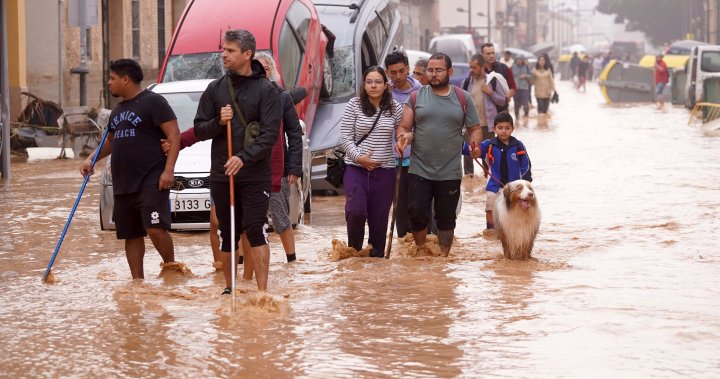At least 63 people died in eastern Spain after floods swept away cars, turned village streets into rivers and disrupted railways and highways in the worst natural disaster to hit the European country in recent memory.
Emergency services in the eastern Valencia region confirmed the deaths of 62 people on Wednesday. The central government office of the Castilla-La Mancha region added that an 88-year-old woman was found dead in the city of Cuenca.
Rainstorms on Tuesday caused flooding across a wide area of southern and eastern Spain, stretching from Malaga to Valencia. Floods of mud-colored water swept vehicles through the streets at high speeds, while pieces of wood were scattered in the water along with household utensils. Police and rescue services used helicopters to extract people from their homes and rubber boats to reach drivers trapped on the roofs of cars.
Spanish Prime Minister Pedro Sanchez said that dozens of towns were flooded.
Story continues below ad
“For those who are searching for their loved ones, all of Spain feels your pain,” Sanchez said in a televised speech. “Our priority is to help you. We are putting all the necessary resources into place so that we can recover from this tragedy.”
Authorities reported several people missing late Tuesday, but the next morning, a shocking announcement was made of dozens dead.
“Yesterday was the worst day of my life,” Ricardo Gabaldon, the mayor of Valencia’s city of Hotel, told national radio RTVE. He added that several people were still missing in his town.
“We were trapped like rats. Cars and garbage containers were flowing in the streets. The water rose to three metres,” he added.
People walk through flooded streets in Valencia, Spain, Wednesday, October 30, 2024.
AP Photo/Alberto Saez
More than 1,000 soldiers from Spanish emergency response units were deployed in the devastated areas. Rescue services also rushed east from other parts of Spain. The Spanish central government formed a crisis committee to help coordinate rescue efforts.
Story continues below ad
An elderly couple was rescued from the top floor of their house by a military unit using a bulldozer, and they were accompanied by three soldiers in the huge shovel.

Get daily national news
Get the day’s top political, economic and current affairs news, headlines, delivered to your inbox once a day.
Television reports showed video clips taken by terrified residents documenting how water flooded the ground floors of apartments, streams overflowed their banks, and bridges collapsed.
Spain has witnessed similar autumn storms in recent years. However, it is nothing compared to the devastation over the past two days, which brings to mind the floods in Germany and Belgium in 2021 that killed 230 people.
The death toll is likely to rise as other areas have not yet reported casualties and search efforts continue in hard-to-reach areas.
In the village of Letur in the neighboring Castilla-La Mancha region, village mayor Sergio Marin Sanchez said six people were missing.
Residents look at cars piled up after they were swept away by floods in Valencia, Spain, Wednesday, October 30, 2024.
AP Photo/Alberto Saez
Trending now
-

The organization says a woman was found dead in an oven at a Halifax Walmart near her mother
-

Sean “Diddy” Combs is accused of sexually assaulting boys between the ages of 10 and 17
Spain is still recovering from severe drought and continues to record record high temperatures in recent years. Scientists say the increase in extreme weather episodes is likely linked to climate change.
Story continues below ad
The storms unleashed a freak hailstorm that blew holes in car windows and greenhouses as well as a rarely seen tornado.
Transportation was also affected. A high-speed train carrying about 300 people derailed near Malaga, although railway authorities said no one was injured. High-speed train service between Valencia and Madrid was halted, as were many passenger lines.
Valencia Regional President Carlos Mazzone urged people to stay home, as road travel was already difficult due to fallen trees and wrecked vehicles. Authorities warned that the danger had not ended with more rain.
Residents look at cars piled up after they were swept away by floods in Valencia, Spain, Wednesday, October 30, 2024.
AP Photo/Alberto Saez
As the water fell, the streets were covered in thick layers of mud.
“The neighborhood is devastated, all the cars are on top of each other, they are literally smashed,” Christian Vienna, a bar owner in the Valencian village of Barrio de la Torre, said by phone. “Everything is complete rubble, everything ready to be disposed of. The mud is about 30cm deep.
Story continues below ad
Outside a Vienna bar, people were venturing out to see what they could salvage. Cars were piled up and streets were filled with clumps of submerged branches.
Located south of Barcelona on the Mediterranean coast, Valencia is a tourist destination known for its beaches, citrus groves and the home of the Spanish rice dish paella.
Like some other regions of Spain, Valencia has small valleys and river basins that spend most of the year completely dry but quickly fill with water when it rains. Many of them pass through populated areas.
The rain subsided in Valencia late Wednesday morning. But more storms are expected until Thursday, according to Spain’s National Meteorological Service.
Associated Press journalist Teresa Medrano in Madrid contributed to this report.
& Edition 2024 The Canadian Press

















